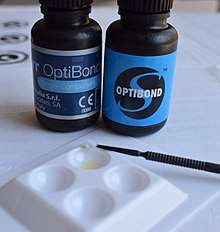Dentine bonding agents
Also known as a "bonderizer" bonding agents (spelled dentin bonding agents in American English) are resin materials used to make a dental composite filling material adhere to both dentin and enamel.

Bonding agents are often methacrylates with some volatile carrier and solvent like acetone. They may also contain diluent monomers. For proper bonding of resin composite restorations, dentin should be conditioned with polyacrylic acids to remove the smear layer, created during mechanical treatment with dental bore, and expose some of the collagen network or organic matrix of dentin. Adhesive resin should create the so-called hybrid layer (consisting of a collagen network exposed by etching and embedded in adhesive resin). This layer is an interface between dentin and adhesive resin and the final quality of dental restoration depends greatly on its properties. Modern dental bonding systems come as a “three-step system”, where the etchant, primer, and adhesive are applied sequentially; as a “two-step system”, where the etchant and the primer are combined for simultaneous application; and as a “one-step system”, where all the components should be premixed and applied in a single application (so-called seventh generation of bonding agents).
Chemical processes involved in bonding to dentine
- Removal of the smear layer and etching of dentine
- Priming of the dentine surface
- Bonding of the primed dentine surface to the restorative material
Removal of the smear layer and dentine etching
A dentine conditioning agent is used initially, to remove the smear layer resulting from the preparation of a cavity and, to alter the dentine surface by partially demineralising the intertubulary dentine. This partially demineralised dentine acts as a hollow scaffolding which can be perfused with the primer. Over-etching (as well as over-drying) of the dentine can lead to collapse of the collagen network, making infiltration of the primer more challenging. However, sclerosed dentine requires a longer time of exposure to the dentine conditioner compared to healthy dentine. Some dentine conditioners contain a chemical called glutaraldehyde, which reinforces the collagen matrix, preventing its collapse.
Some common dentine conditioners include:
- phosphoric acid
- nitric acid
- maleic acid
- citric acid
- ethylene diamine tetra-acetic acid (EDTA)